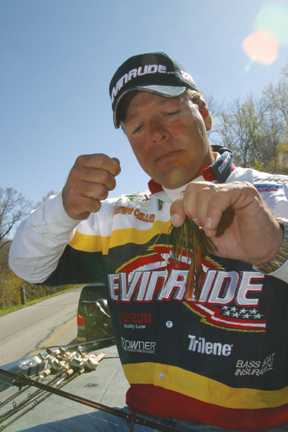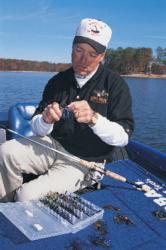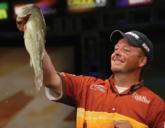Hog tied

Davy Hite goes hog wild in pursuit of big bass
Plus sidebar: ‘Dion Hibdon’s casting jigs’
Want to make Davy Hite’s day? Hand this former Wal-Mart FLW Tour champion a flipping rod matched with a jig-and-pig and point him toward shallow bass cover. As with many successful tournament anglers, Hite can deftly flip and pitch a jig into tiny openings and penetrate dense bass lairs.
Few lures slither into heavy cover as well as the jig-and-pig. Combine this ability with the lure’s proven big-bass appeal, and it’s easy to understand why so many anglers rely on a jig-and-pig to dig bass out of nasty tangles.
What puzzles Hite is why so many anglers abandon the jig-and-pig when they cast to offshore structure. Hite isn’t complaining, mind you. Casting a jig has won him a pile of cash, and he doesn’t mind having an advantage.
“The jig-and-pig is a superior big-bass lure,” Hite said. “That’s true whether you’re fishing flooded bushes or river ledges. When you fish structure away from the bank, the jig shows bass something other than the crankbaits and Carolina rigs they’re used to seeing.”
Hite also dotes on the jig’s high strike-to-catch ratio and its ability to catch bass at any depth. He takes bass with a jig-and-pig from less than 1 foot to more than 50 feet deep.
Consider a December tournament Hite fished on Georgia’s Lake Lanier. By casting a 1-ounce jig tipped with a plastic chunk, he plucked limits of magnum spotted bass from submerged standing timber 60 feet deep. To speed the jig’s fall, Hite opted for 14-pound FireLine, which has the diameter of 8-pound-test monofilament. The low-stretch superline also insured solid hookups.
“I was swimming and pumping the jig,” Hite said. “When I hit a limb, I’d slow down and work the jig through the treetop. I wasn’t getting many bites, but all the spots I caught were big ones, up to 3 1/2 pounds.”
After two days of the three-day event, Hite held third place and was poised for victory. High winds on the final round blew him off his big-fish hole. But thanks to the jig, Hite still managed to collect a check and earn valuable points.
Open Hite’s jig box and you’ll see an array of Lunker Lure Rattleback jigs. They range from 1/4 ounce to 1 ounce in weight. Some jigs are flipping models that sport a heavy hook. Others have lighter casting hooks for easier penetration.
Jigs in 3/8-ounce and 1/2-ounce weights are Hite’s workhorses, but he uses all sizes to overcome varying fishing conditions. A 1/4-ounce jig excels in thin, quiet water. A 3/4-ounce or 1-ounce jig overcomes extremely deep water or heavy current situations. A heavy jig also lets Hite fish medium depths with an upbeat pace that sparks reflex strikes.
Hite usually tips his jigs with Gambler’s soft-plastic Flex Chunk. The Flex Chunk is similar in shape to a pork frog. It has two narrow channels across the chunk’s belly, however, to give the bait more flexibility.
As for colors, Hite sticks to a few proven hues, including black and blue, green pumpkin, gourd green, Texas craw, and white. He usually casts dark colors in murky water and light colors in clear water, although he regards black and blue as universal.
Tackle and retrieves
A 7-foot Pflueger medium-heavy Trion rod gives Hite the leverage needed to cast jigs long distances. He often makes long casts to avoid spooking bass and to cover more water. The long, stout rod also slams home the hook. Hite usually fills his bait-casting reel with low-stretch 17- or 20-pound-test Trilene IronSilk polymer fishing line. FireLine gets the call when Hite needs a no-stretch line to overcome vegetation or especially deep water.
“I swim a jig a lot in clear water,” Hite said. “It’s more of a horizontal presentation. I often search ledges or flats that have scattered cover. I experiment with swimming, pumping and hopping retrieves.”
If the bottom is strewn with boulders, stumps or grass clumps, Hite fishes fast until he contacts one of these objects. Then he does a little shake-and-bake to let the rattle work its magic before jumping the jig over the cover.
Casting a jig pays off for Hite any time bass relate to offshore structure. This covers all seasons, with the exception of the major spawning phase. The most productive time is the postspawn period.
“When bass first move out from the shallows, they don’t attack crankbaits well,” Hite said. “They also may suspend above the bottom. That makes them less susceptible to Carolina rigs. If the bass suspend no higher than 7 feet, I can catch them by jumping a jig high off the bottom.”
A high jig hop came through for Hite when he fished a tournament on Lake Eufaula in May. Unseasonably warm weather and high water had put the bass into a funk. Some bass were shallow; bass that had gone deep were temperamental and not feeding aggressively.
While other anglers struggled to catch bass offshore, Hite compiled more than 55 pounds over three days casting a 3/8-ounce jig to ledges 18 feet deep. He finished third.
“The bass at Eufaula ignored my jig when I hopped it close to the bottom,” Hite said. “But when I popped the jig up 5 or 6 feet, they’d nail it.”
Hite has learned not to get stuck on any type of jig retrieve. The mood of the bass can change drastically from one tournament to the next. Sometimes bass will hug the bottom in a sweet spot no larger than a kitchen table. In such a situation, lifting a jig high like Hite did on Eufaula won’t get you anywhere.
In many tournaments, Hite discovers multiple bass patterns. It’s common for him to find some bass snuggling up to shallow cover and others relating to midlake structures. When this occurs, Hite typically goes for the shallow bass first and works the deeper fish in the middle of the day.
“I usually do better offshore during the midday hours,” Hite said. “That’s because there is better light penetration then, especially in clear water. Bass can see better and are more likely to respond to my jigs.”
Lighten up
Hite never has trouble finding his jig box, chunks and other lures. Look into the middle compartment on the front deck of his bass boat and you’ll see a practically empty cavern. Scattered across the bottom will be a few bags of plastic baits and selected flat utility boxes.
“Most fishermen carry too many baits in their boats,” Hite said. “I empty my boat after every tournament and put in only the baits I need for the body of water I’ll be fishing. My truck overflows with every kind of bass lure known to mankind, but I hold the baits in my boat to a bare minimum.”
Fewer baits allow Hite to be more organized and less cluttered. It also improves his boat’s performance.
“If you load every boat compartment with tackle boxes, it adds up to hundreds of pounds,” Hite said. “By keeping my boat light, it handles better on rough water, and no one ever passes me.”
Quality vs. quantity
In a tournament, the size of the bass usually takes precedence over numbers of fish. This is what keeps the jig-and-pig at the top of Hite’s priority list.
“When I’m competing, my goal is five big fish,” Hite said. “A jig may not catch bunches of bass, but it gives me the quality I need. If I’m fishing for fun with my son, I’ll switch to a Carolina rig. In that situation, I want to get as many bites as I can. It doesn’t matter how big they are.”
Related article

